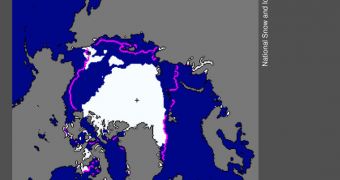The latest monthly analysis of sea ice spread in the Arctic reveals that current extents have dropped below the critical mark of 4 million square kilometers (1.54 million square miles). This level was registered at a time when the end of the 2012 melting season was still a couple of weeks ago.
Experts from the US National Snow and Ice Data Center (NSIDC) have found that this extremely low coverage level was reached on August 26. Compared to records covering September, collected in the 1980s and 1990s, current levels are 45 percent lower.
This is an incredible difference, visible in the image to the left as well. The pink outline shows the average sea ice extent for 1979 to 2000. It is currently becoming quite clear that global warming and climate change are to blame for the melt, since no seasonal variation could account for this difference.
According to scientists, sea ice levels recorded in August consistently tracked below values recorded in 2007, which was the year when the lowest sea ice extent record was set. There is a distinct possibility that 2012 will exceed 2007 in terms of overall ice loss.
Average sea ice extent for the month of August was 4.72 million square kilometers (1.82 million square miles), significantly lower than the values recorded in August 2007, and even more so than median values for 1979-2000.
“On August 26, the 5-day running average for ice extent dropped below the previous record low daily extent, observed on September 18, 2007. By the end of the month, daily extent had dropped below 4.00 million square kilometers (1.54 million square miles),” the NSIDC team reports.
The experts add that the typical Arctic melting season ends around mid-September. However, instances of it continuing beyond this time have been recorded as well.
An important aspect of the study deals with multi-year ices, the most important variety in the Arctic. These are ices that formed years ago, and withstood melting for all this time. Currently, perennial ice loss levels are higher than ever before.
Ice dynamics studies have demonstrated that – even though multi-year ices melt slower – they also form at a slower pace than regular, single-year ices. This means that there's a big chance of multi-year ices melted during a season not being restored the next winter.
“The last few summers have seen increased losses of multi-year ice in the Pacific sector of the Arctic; multi-year ice that is transported into the Beaufort and Chukchi seas tends to melt out in summer before being transported back to the central Arctic Ocean through the clockwise Beaufort Gyre circulation,” the team says.
“The ice on the Pacific side of the Arctic has melted back to the edge of the multiyear ice cover, which should help to slow further ice loss in the region. In the Laptev Sea, by contrast, a large amount of first-year ice remains,” the team concludes.

 14 DAY TRIAL //
14 DAY TRIAL //